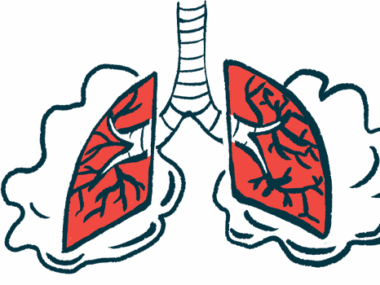SSc-ILD Patients on Ofev See Twofold Lung Decline Over Healthy Matches
Written by |

Note: This story was updated June 14, 2023, to correct that patients receiving Ofev in the SENSCIS trial experienced a fourfold decline in lung function compared with a hypothetical group of matched healthy references, while those given Ofev declined by twofold.
People treated with Ofev (nintedanib) for interstitial lung disease associated with systemic sclerosis (SSc-ILD) had a twofold loss of lung function over one year compared to a hypothetical group of matched healthy references whose lung function declines naturally with age, an analysis of the SENSCIS trial showed.
People treated with Ofev (nintedanib) for interstitial lung disease associated with systemic sclerosis (SSc-ILD) had a twofold greater loss of lung function over one year compared to a hypothetical group of matched healthy references, whose lung function declines naturally with age, an analysis of the SENSCIS trial showed.
The analysis also showed that SSc-ILD patients given a placebo declined four times more than the hypothetical healthy references, demonstrating that while lung function still declines more than usual in people taking Ofev, lung function decline is much greater if patients do not receive any treatment.
These data put the results of the SENSCIS trial into context and highlight the clinical relevance of slowing lung decline by Ofev, the researchers said.
The study, “Decline in forced vital capacity in subjects with systemic sclerosis-associated interstitial lung disease in the SENSCIS trial compared with healthy reference subjects,” was published in Respiratory Research.
Systemic sclerosis, also called scleroderma, is marked by fibrosis (tissue scarring) of multiple organs. When the tissue in and around the lungs’ air sacs becomes scarred and inflamed, impairing lung function, the condition is known as interstitial lung disease associated with systemic sclerosis (SSc-ILD).
Ofev was the first therapy approved to support lung function in people with SSc-ILD, based on data from the global Phase 3 SENSCIS trial (NCT02597933). The study demonstrated that 52 weeks (one year) of Ofev slowed lung function decline by 44% relative to a placebo in 576 adults with SSc-ILD.
Lung function in SENSCIS was assessed by forced vital capacity (FVC) — the total amount of air that can be exhaled after a deep breath. A decline in FVC is an established indicator of ILD progression.
FVC also declines slowly with age in healthy people and can vary with sex, ethnicity, and height.
Lung function with SSc-ILD
An international team of researchers, along with Boehringer Ingelheim, compared FVC over the SENSCIS trial with values in hypothetical healthy reference individuals matched for age, sex, ethnicity, and height.
The study’s goal was to “obtain insights into the decline in lung function in patients with SSc-ILD” and to “put the findings of the SENSCIS trial into context,” the research team wrote.
“To our knowledge, this is the first study to compare deterioration in lung function in patients with SSc-ILD with the decline that would be expected due to the natural ageing process,” the researchers wrote.
FVC values for the reference individuals were obtained from the European Respiratory Society Global Lung Function Initiative, which contains data collected from more than 70,000 healthy people ages 3–95 years across 26 countries. Almost half (48.4%) of the trial participants had been taking a regular dose of mycophenolate for six months or more.
At the SENSCIS trial baseline (study’s start), the mean FVC in patients assigned Ofev was 2,460 mL compared to 3,403 mL in the hypothetical healthy reference group. There was a similar difference in the placebo versus the reference group. This showed a “substantial decline in lung function” before the study, the researchers noted.
The mean change in FVC after one year of Ofev was a decline of 52.9 mL versus 103.4 mL in the placebo group.
In comparison, the decline in FVC in the reference group over the same period, based on age-related loss of lung function, was about 26 mL. Thus, the difference in the change in FVC between the Ofev group and matched references was about twofold, while the change in the placebo group and healthy references was about fourfold.
“The patients enrolled in the SENSCIS trial experienced marked worsening of lung function over the following year,” the researchers wrote.
In a subgroup analysis, there was no significant difference in the change in FVC between the Ofev and the healthy reference group in those who did or did not use mycophenolate at baseline. Among the patients who received a placebo, there was a significant difference in the change in FVC compared to healthy references, both with and without mycophenolate, however.
Similar findings were seen when comparing those with FVC under or of at least 70% at baseline, the presence or absence of cough or shortness of breath, or more or less than three years since their first non-Raynaud symptom.
The team then estimated the “effective lung age” — the age of healthy individuals with the same FVC — of SENSCIS participants based on their FVC, sex, ethnicity, and height. “This is the first time that effective lung age has been estimated in subjects with ILD,” the investigators noted.
The mean effective lung age of trial participants was about 83 years at baseline, representing a difference of about 29 years compared to their actual age. More than 70% of patients had more than 20 years difference between the mean effective lung age and actual lung age.
At baseline, the median effective lung age was about 88 years in both the Ofev and placebo groups. After one year, the median effective lung age was 91.0 years in the Ofev group and 95.0 in the placebo group.
These analyses show that the patients in the SENSCIS trial “had markedly impaired lung function at baseline and experienced further deterioration over 52 weeks,” the authors concluded. These data “help to put the results of the SENSCIS trial into context and highlight the clinical relevance of the slowing of FVC decline provided by [Ofev].”






